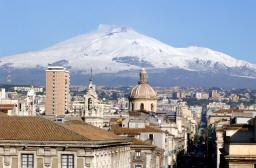Researchers studying Mount Etna in Sicily have discovered that Europe's most active volcano 'breathes', inflating and deflating in cycles.
A study of Etna's eruptions in the last 15 years by the Italian Institute of Geophysics and Vulcanology (INGV) and published in Geophysical Research Letters reveals that build-ups of magma made Etna swell up between 1993 and 2000, initially by around one centimetre a year but then by progressively smaller measurements.
At the same time, the researchers noted eruptions at the summit of the volcano.
Between 2001 and 2005, Etna deflated again, resulting in displacements of the eastern flank and the formation of fissures in the sides of the volcano accompanied by lateral eruptions, according to the study.
The researchers say the joint interpretation of volcano deformation and stored magma rates could be crucial in identifying impending eruptions.
Although Etna is in an almost constant state of eruption, the last bout of serious volcanic activity was in 2002-3, when a huge eruption destroyed tourist stations and damaged houses, while ash fell 600 km away in Libya.
Eruptions in 2001 also made international headlines as parts of an important ski resort, the Rifugio Sapienza, were engulfed and the town of Nicolosi was threatened with a similar fate.
Viewers around the world were also held spellbound by the beauty of the spectacle, which experts said was one of the most ''unusual and complex'' eruptions in three centuries.
The volcano's previous major eruption was in 1992, when the Italian military had to use controlled explosions to divert lava away from the town of Zafferana on the mountain's lower slopes.
Etna is Europe's highest active volcano, at 3,295 metres (10,810 feet).












